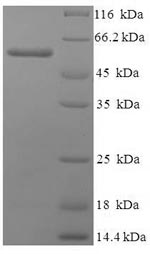The synthesis of this Recombinant Human PABPC1 protein depends on the utilization of recombinant DNA technology. DNA sequences that encoded the PABPC1 protein could be inserted into a vector and introduced into an expression host, E.coli, where it could be easily expressed in and purified from. The expression of this PABPC1 protein was at 1-370aa. N-terminal 6xHis-SUMO tag was fused with this protein. The purity is 90%+ determined by SDS-PAGE.
PABPC1 (also known as PAB1 or PABP) is gene encoding a protein named polyadenylate-binding protein 1 (PABPC1 or PABP-1) in human. The protein encoded by this gene is also known as poly(A)-binding protein 1. Increasing studies has shown that the protein encoded by PABPC1 gene is cleaved during poliovirus and coxsackievirus infection by viral 3Cprotease and that 3Cprotease modification of a subset of PABP can result in significant translation inhibition. The encoded protein can bind to mRNA 3'-UTR, poly(A), poly(U) RNA and protein C-terminus. It is involved in multiple biological processes with its translation activator activity.






